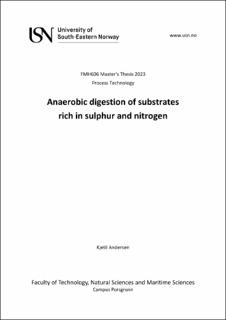| dc.description.abstract | There is an increase interest in producing biogas from organic waste, such as cow manure and fish sludge. The government in Norway is encourages farmers to invest in biogas facilities with financial incentives. A recently started biogas facility is Svanem Biogass AS, which is located at the coast of Trøndelag in Norway. The facility runs on cow manure from several local farmers and fish sludge from the salmon aquaculture in the area. The substrate is rich in nitrogen and sulphur and measures need to be taken to avoid inhibiting the digester due to excess ammonia and reduce the level of hydrogen sulphide in the biogas. It is considered favourable to reduce the hydrogen sulphide in-situ the biogas rector rather than invest in costly equipment for conditioning the biogas. However, the main goal for Svanem Biogass AS is to produce high quality natural fertiliser. The measures cannot affect the quality, nor be too expensive.
To avoid inhibiting the digester due to ammonia, there are two methods that is considered appropriate for Svanem Biogass AS. These methods are slowly stepwise increase of content of fish sludge in the substrate mixture and temperature control. When using a stepwise change in the substrate mixture, the microflora manages to adopt to a change in the substrate. Especially the methanogens need time to adopt to the changes. Temperature reduction within the range of mesophilic condition should be considered when inhibition of ammonia occurs.
Reduction of hydrogen sulphide can be achieved by adding air or oxygen to the head space of the biogas reactor or by adding iron to the substrate. Close to Svanem Biogass AS there is a waterworks with wastewater rich on iron. Simulation shows that with the correct amount of iron added to the substrate, the hydrogen sulphide level can be significant decreased. Adding iron rich water to the substrate is considered as a low-cost measure to reduce the hydrogen sulphide in the biogas without conditioning the biogas afterwards. | |
